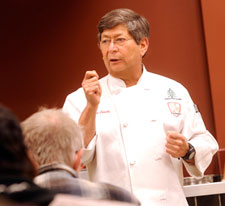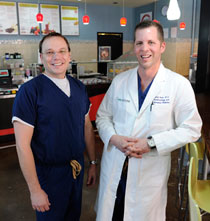UAB Alumni Cook Up New Flavors for Cancer Patients
By Susannah Felts
 Birmingham oncologist Luis Pineda attended culinary school to teach himself how to make food more palatable to cancer patients. He has shared the fruits of his learning in a cookbook and in person at workshops in partnership with UAB's Comprehensive Cancer Center.A brief bout with nausea or stomach flu is enough to remind most of us that enjoying food is a wonderful thing. For people struggling with cancer and many other long-term medical conditions, a changed relationship with food can be one of the most troubling outcomes.
Birmingham oncologist Luis Pineda attended culinary school to teach himself how to make food more palatable to cancer patients. He has shared the fruits of his learning in a cookbook and in person at workshops in partnership with UAB's Comprehensive Cancer Center.A brief bout with nausea or stomach flu is enough to remind most of us that enjoying food is a wonderful thing. For people struggling with cancer and many other long-term medical conditions, a changed relationship with food can be one of the most troubling outcomes.
Chemotherapy and radiation treatment, in particular, wreak havoc on taste, smell, and digestion, leaving patients with little appetite and difficulty consuming meats and hot or crunchy foods. Both treatments damage salivary glands and taste receptors in the mouth and nose. They also create a wide range of gastrointestinal problems, along with mouth inflammation, ulcers, and dryness.
In his Birmingham oncology practice, Luis Pineda, M.D., observed many patients turning down meals and meal-replacement shakes. Those skipped meals ultimately translate to “poor nutrition and, eventually, poor outcomes,” notes Pineda, who completed a fellowship at the UAB School of Medicine in 1982 and was one of the original members of UAB’s bone marrow transplant program.
A lifelong food-lover, Pineda decided to address the problem. So he enrolled in Birmingham’s Culinard cooking school to explore how to make food that was more palatable for cancer patients.
Palate Pleasers
After two years of weekend classes at Culinard, Pineda unveiled Cooking with Cancer in 2005 as a cookbook, Web site, and DVD. In each format, Pineda offers recipes designed to appeal to cancer patients while fulfilling their special nutritional needs. Take, for example, a plantain ice cream that contains very finely ground charcoal, which is often prescribed in pill or liquid form to absorb stomach acid. The charcoal, in combination with the fiber-rich plantains, may help regulate bowel function, a common problem for cancer patients, while the cool, creamy texture works well for patients with mouth inflammation.
|
The Joy of Eating In 2011, Luis Pineda's Cooking with Cancer Inc. teamed up with Culinard at Virginia College and the UAB Comprehensive Cancer Center to offer a series of hands-on cooking classes designed for the unique needs of patients with cancer. Find the recipe for one dish, Hainanese Chicken Rice, here. |
While many of his recipes may seem exotic at first glance, Pineda stresses that they are simple and affordable to prepare. “I’m using ingredients that may be part of a normal diet, but using them in an expression that translates to a better quality of life for cancer patients,” he says.
The capsaicin in hot peppers, for example—used by Pineda in a jalapeño soup and ice cream—can help combat the nausea and vomiting associated with chemotherapy. Spicy dishes in general, and those with strong flavor contrasts, such as a mango-cilantro sorbet, can refresh, or repolarize, taste receptors damaged by radiation, he explains.
Pineda is still hard at work creating new dishes in his home kitchen, which is packed with special equipment such as a vacuum machine and an ultrasonic blender. Lately, he’s been working on a method of slow-cooking meats so they can be enjoyed by people who find chewing difficult. “When you bite into it, it’s almost like biting into a gelatin,” Pineda says. “The meat has precisely the same flavor, but chewing is not critical.”
All of Pineda’s recipes are patient-tested, he says, and he encourages visitors to tweak his recipes, or submit their own, on the Cooking with Cancer site at www.cookingwithcancer.org. Although he has been approached by companies wanting to sell his cookbook, Pineda continues to give it away for free in an e-book version online.
Cold Comfort
 UAB registered nurse Randy Lucas (left) and anesthesiologist
UAB registered nurse Randy Lucas (left) and anesthesiologist
Ronald Roan, M.D., are
providing a healthy alternative
to traditional desserts with
a self-serve yogurt shop across
from UAB Hospital.Cold soups, ice creams, and other cool, smooth concoctions are good options for cancer patients because “the milk contains a lot of protein and calories, which the patient uses as nutritional support,” Pineda says. Plus cold, easy-to-swallow foods are more palatable for people with oral inflammation, he notes.
That may be one reason why the cool treats at Zen Yogurt have been a hit with patients at the Comprehensive Cancer Center and among the UAB community at large. Longtime friends Ronald Roan, M.D., a UAB anesthesiologist and 2000 graduate of the UAB School of Medicine, and Randy Lucas, R.N., a UAB registered nurse, say they opened Zen Yogurt after recognizing the lack of healthy snack or dessert options near the medical center. The self-serve shop, located across the street from UAB Hospital, began offering six rotating flavors of probiotic-rich yogurt and a wide variety of high-protein shakes and smoothies in November 2010.
Before long, Roan and Lucas noticed that nurses from the Cancer Center were stopping in regularly to buy high-protein shakes as treats for their patients. Family members of patients are becoming loyal customers, too: “Last week, I had a woman come in looking for something for her husband,” says Roan. “He was undergoing chemotherapy and had oral inflammation, and our shakes were the only thing she could get him to eat. She came in once or twice a day for about a week.”
Roan and Lucas say they didn’t anticipate this particular niche clientele when they opened Zen Yogurt, but they’re happy to meet its needs. “We want to give back to the community and create a service of value,” Lucas says.